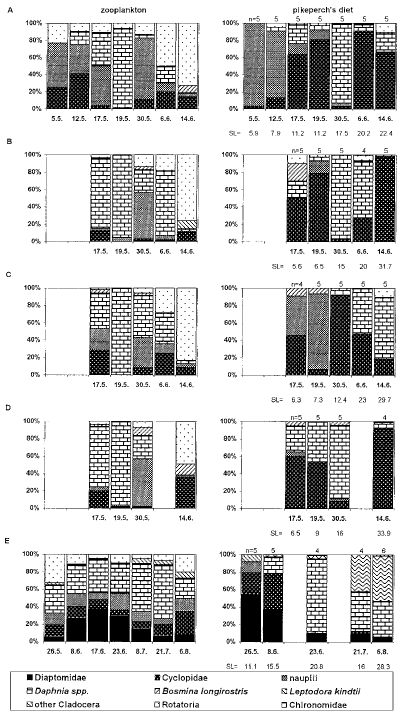 Diet of larval and juvenile pikeperch (Stizostedion lucioperca) reared in ponds was investigated and compared with the diet of pikeperch from a reservoir. The standard length of first feeding pikeperch larvae in ponds was 6.1 mm, on average, and although rotifers were present in the diet, their numerical contribution can be considered as insubstantial. Rotifers were soon replaced by nauplii of cyclopoid copepods, which were highly positively selected and contributed largely to the diet up to a larval length of 10 mm. Daphnia spp. were consumed from the onse tof exogenous feeding, but were not positively selected until 15 mm. Another smaller cladoceran Bosmina longirostriswas highly negatively selected and did not contribute significantly to the diet. A clearpositive selection for larger relatively to smaller prey and a preference for Daphnia from a body length of 15 mm onwards could be observed. In the reservoir, rotifers were not found in the diet of pikeperch larvae even inthe smallest individuals. Dominant food items were nauplii and 1st copepodite instar of Eudiaptomus gracilis and Cyclops spp. Cladocerans – Daphnia galeata and to a lesser extent Diaphanosomabrachyurum appeared in the pikeperch diet at alength of about 10 mm. A shift from copepods to Daphnia spp. and especially Leptodora kindtii could be recognised inpikeperch at a length of 20 mm. When comparing ourdata from nursing ponds with the data from Římov reservoir, similar trends in dietcomposition were observed.
Diet of larval and juvenile pikeperch (Stizostedion lucioperca) reared in ponds was investigated and compared with the diet of pikeperch from a reservoir. The standard length of first feeding pikeperch larvae in ponds was 6.1 mm, on average, and although rotifers were present in the diet, their numerical contribution can be considered as insubstantial. Rotifers were soon replaced by nauplii of cyclopoid copepods, which were highly positively selected and contributed largely to the diet up to a larval length of 10 mm. Daphnia spp. were consumed from the onse tof exogenous feeding, but were not positively selected until 15 mm. Another smaller cladoceran Bosmina longirostriswas highly negatively selected and did not contribute significantly to the diet. A clearpositive selection for larger relatively to smaller prey and a preference for Daphnia from a body length of 15 mm onwards could be observed. In the reservoir, rotifers were not found in the diet of pikeperch larvae even inthe smallest individuals. Dominant food items were nauplii and 1st copepodite instar of Eudiaptomus gracilis and Cyclops spp. Cladocerans – Daphnia galeata and to a lesser extent Diaphanosomabrachyurum appeared in the pikeperch diet at alength of about 10 mm. A shift from copepods to Daphnia spp. and especially Leptodora kindtii could be recognised inpikeperch at a length of 20 mm. When comparing ourdata from nursing ponds with the data from Římov reservoir, similar trends in dietcomposition were observed.
Growth of pikeperch was found significantly faster in nursing ponds than in the reservoir. Slow growth of reservoir pikeperch was probably an artefact due to the prolonged spawning period in the reservoir. Larvae and juvenilesfrom later spawnings decreased the average size of the population over the studied period. Innursing ponds lowest average standard length at harvest was found in the pond with the highest numbers of fish, and vice versa in the pond with the lowest numbers the largest standard length was recorded. This result corresponds to the increased intracohort food competition among juvenile pikeperch with increasing stocking density.
Keywords: diet composition; fishpond; food selection; growth; reservoir
